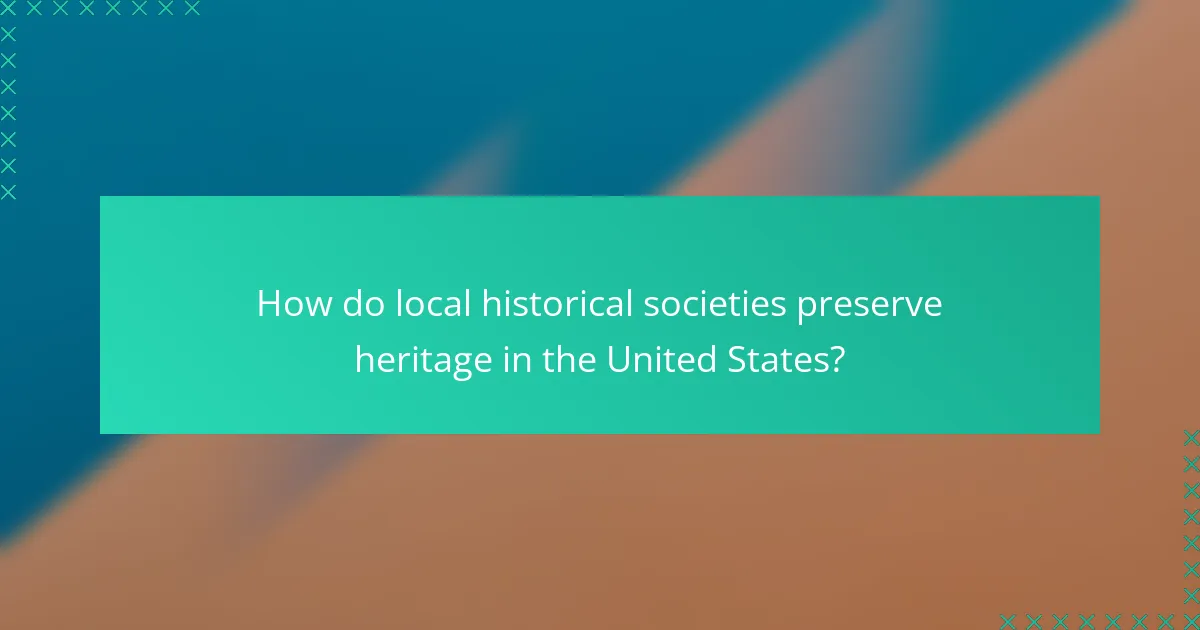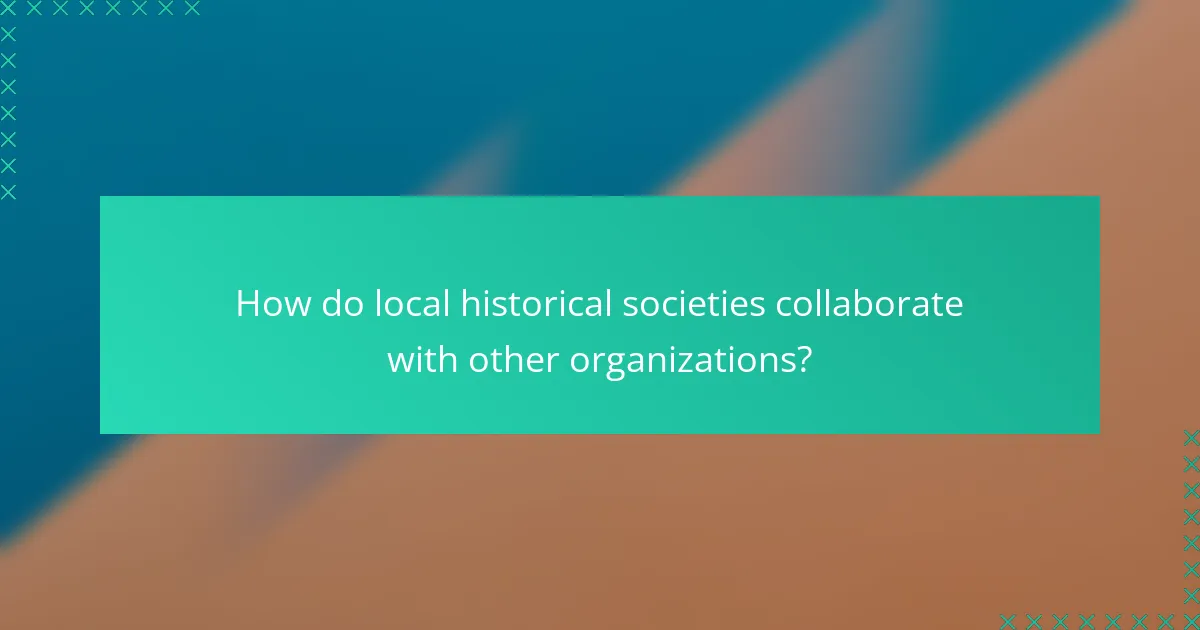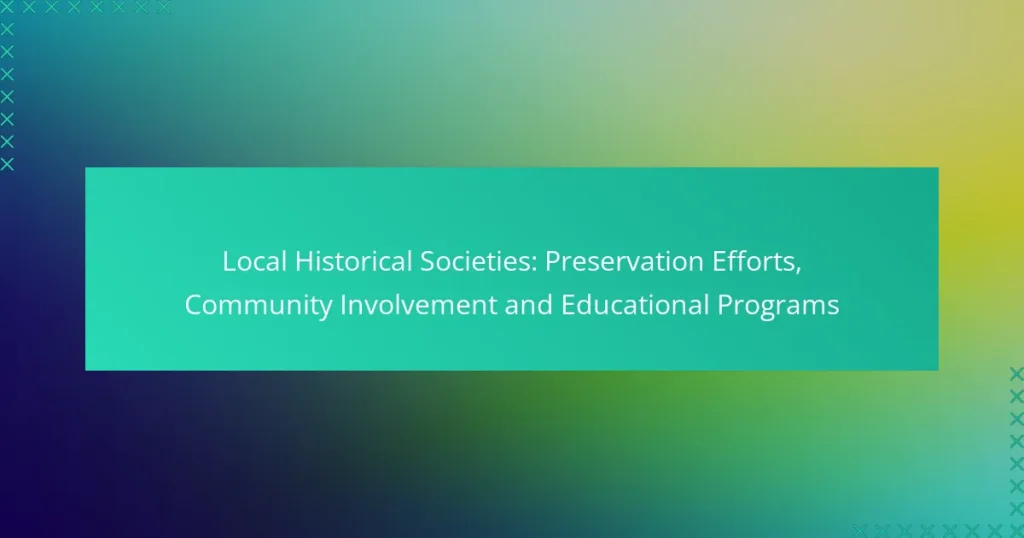Local historical societies are essential in preserving cultural heritage by documenting and restoring significant sites and artifacts. They actively involve the community in preservation efforts and educational programs, fostering a sense of belonging and promoting awareness of local history for future generations.

How do local historical societies preserve heritage in the United States?
Local historical societies play a vital role in preserving heritage by documenting, restoring, and archiving significant cultural sites and artifacts. They engage communities in these efforts, ensuring that local history is maintained for future generations.
Documentation of historical sites
Documenting historical sites involves creating detailed records of their significance, architecture, and historical context. This process often includes photography, written descriptions, and mapping, which help to establish a comprehensive understanding of the site’s importance.
Many societies utilize tools like the National Register of Historic Places to guide their documentation efforts. This ensures that sites are recognized and protected under federal and state laws, which can provide funding and resources for preservation.
Restoration of historical buildings
Restoration of historical buildings focuses on returning structures to their original condition while maintaining their historical integrity. This often requires skilled craftsmen who specialize in traditional building techniques and materials.
Local historical societies may organize fundraising campaigns or grant applications to finance restoration projects. Engaging the community through volunteer opportunities can also enhance local investment in these efforts, fostering a sense of ownership and pride.
Archiving local artifacts
Archiving local artifacts involves collecting, preserving, and cataloging items that reflect the community’s history. This can include documents, photographs, tools, and personal items that tell the story of the area.
Effective archiving requires proper storage conditions to prevent deterioration, such as climate control and protective materials. Societies often offer workshops to educate the public on how to care for personal historical items, encouraging broader community involvement in preservation.
Collaboration with preservation organizations
Collaboration with preservation organizations enhances the capacity of local historical societies to undertake significant projects. By partnering with state and national organizations, societies can access expertise, funding, and resources that may not be available locally.
These collaborations can lead to joint initiatives, such as educational programs and community events, which raise awareness about the importance of heritage preservation. Networking with other organizations also allows for the sharing of best practices and successful strategies in preservation efforts.

What community involvement opportunities exist with local historical societies?
Local historical societies offer various community involvement opportunities that allow residents to engage in preservation efforts, participate in educational programs, and contribute to local history. These opportunities foster a sense of belonging and promote awareness of local heritage.
Volunteer programs for restoration projects
Volunteer programs for restoration projects enable community members to actively participate in preserving historical sites. These programs often include tasks such as cleaning, repairing, and maintaining buildings or artifacts, providing hands-on experience in heritage conservation.
Individuals interested in volunteering can typically sign up through the society’s website or during community events. Many societies offer training sessions to equip volunteers with the necessary skills and knowledge, ensuring effective and safe participation.
Community events and workshops
Community events and workshops organized by local historical societies provide opportunities for residents to learn about their history while engaging with others. These events may include lectures, guided tours, and interactive workshops focused on various historical topics or preservation techniques.
Participation in these events often requires registration, which can usually be done online. Societies may charge a nominal fee for workshops to cover materials, but many events are free, encouraging broad community participation.
Membership benefits and engagement
Joining a local historical society as a member offers numerous benefits, including access to exclusive events, newsletters, and educational resources. Membership often includes discounts on workshops and events, as well as opportunities to network with other history enthusiasts.
Engagement as a member can lead to deeper involvement in projects and initiatives, allowing individuals to contribute their skills and ideas. Many societies also encourage members to participate in decision-making processes, fostering a collaborative environment for preserving local history.

How do local historical societies educate the public?
Local historical societies educate the public through various initiatives that promote awareness and appreciation of local history. These efforts often include guided tours, educational programs for schools, and public lectures, all aimed at engaging the community and fostering a deeper understanding of historical contexts.
Guided tours of historical sites
Guided tours of historical sites provide an immersive experience for participants, allowing them to explore significant locations while learning about their historical importance. These tours often highlight local architecture, notable events, and influential figures, making history tangible and relatable.
Typically, tours are conducted by knowledgeable volunteers or staff members who share stories and insights. They may vary in length from one hour to several hours, depending on the site and the depth of information provided. It’s advisable to check for any fees or required reservations in advance.
Educational programs for schools
Educational programs for schools are designed to integrate local history into the curriculum, enhancing students’ learning experiences. These programs may include interactive workshops, field trips to historical sites, and hands-on activities that align with educational standards.
Local historical societies often collaborate with teachers to tailor these programs to specific grade levels and subjects. They may offer resources such as lesson plans or materials that help educators effectively convey historical concepts to students.
Public lectures and seminars
Public lectures and seminars provide opportunities for community members to engage with historians, authors, and experts on various historical topics. These events often cover a wide range of subjects, from local history to broader historical themes, and encourage audience participation through Q&A sessions.
Typically held in community centers or libraries, these events are often free or low-cost, making them accessible to a broad audience. Attendees can benefit from the knowledge shared and may also discover additional resources for further exploration of the topics discussed.

What are the funding sources for local historical societies?
Local historical societies typically rely on a mix of funding sources to support their preservation efforts, community involvement, and educational programs. These sources include grants from government agencies, donations from community members, and fundraising events and campaigns.
Grants from government agencies
Government agencies at the local, state, and federal levels often provide grants to support historical preservation initiatives. These grants can vary significantly in amount, typically ranging from a few thousand to several hundred thousand dollars, depending on the project scope and agency priorities.
To secure these grants, societies must submit detailed proposals outlining their projects, budgets, and expected outcomes. It’s essential to stay informed about application deadlines and eligibility requirements, as these can differ among agencies.
Donations from community members
Community donations play a crucial role in funding local historical societies. Individuals and businesses may contribute financially or provide in-kind support, such as materials or volunteer hours. Societies often cultivate relationships with donors through outreach and engagement efforts.
Establishing a membership program can encourage ongoing support, with members receiving benefits such as newsletters, event invitations, and exclusive access to resources. Societies should consider recognizing donors publicly to foster goodwill and encourage further contributions.
Fundraising events and campaigns
Fundraising events and campaigns are vital for generating additional revenue for local historical societies. Common activities include auctions, bake sales, guided tours, and educational workshops. These events not only raise funds but also enhance community engagement and awareness of local history.
When planning fundraising events, it’s important to set clear financial goals and promote the events effectively through social media and local networks. Societies should also evaluate the success of past events to refine their strategies and maximize future fundraising efforts.

How do local historical societies collaborate with other organizations?
Local historical societies often collaborate with various organizations to enhance their preservation efforts and community engagement. These partnerships can lead to shared resources, increased visibility, and more impactful educational programs.
Partnerships with museums
Local historical societies frequently partner with museums to curate exhibitions that highlight regional history. These collaborations can involve sharing artifacts, co-hosting events, or developing educational materials that benefit both entities. For example, a historical society might lend items for a museum exhibit, while the museum provides expertise in display techniques.
Such partnerships can also lead to grant opportunities, as combined efforts may attract funding from local or national sources. Societies should consider aligning their missions with those of nearby museums to create mutually beneficial relationships.
Joint events with cultural institutions
Joint events with cultural institutions, such as libraries or art centers, allow historical societies to reach broader audiences. These events can include workshops, lectures, or festivals that celebrate local history and culture. For instance, a historical society might collaborate with a library to host a speaker series on local heritage topics.
When planning joint events, it’s essential to communicate clearly about roles and responsibilities. Societies should ensure that promotional efforts are coordinated to maximize attendance and engagement. Additionally, offering interactive elements, like hands-on activities or guided tours, can enhance the experience for participants.


